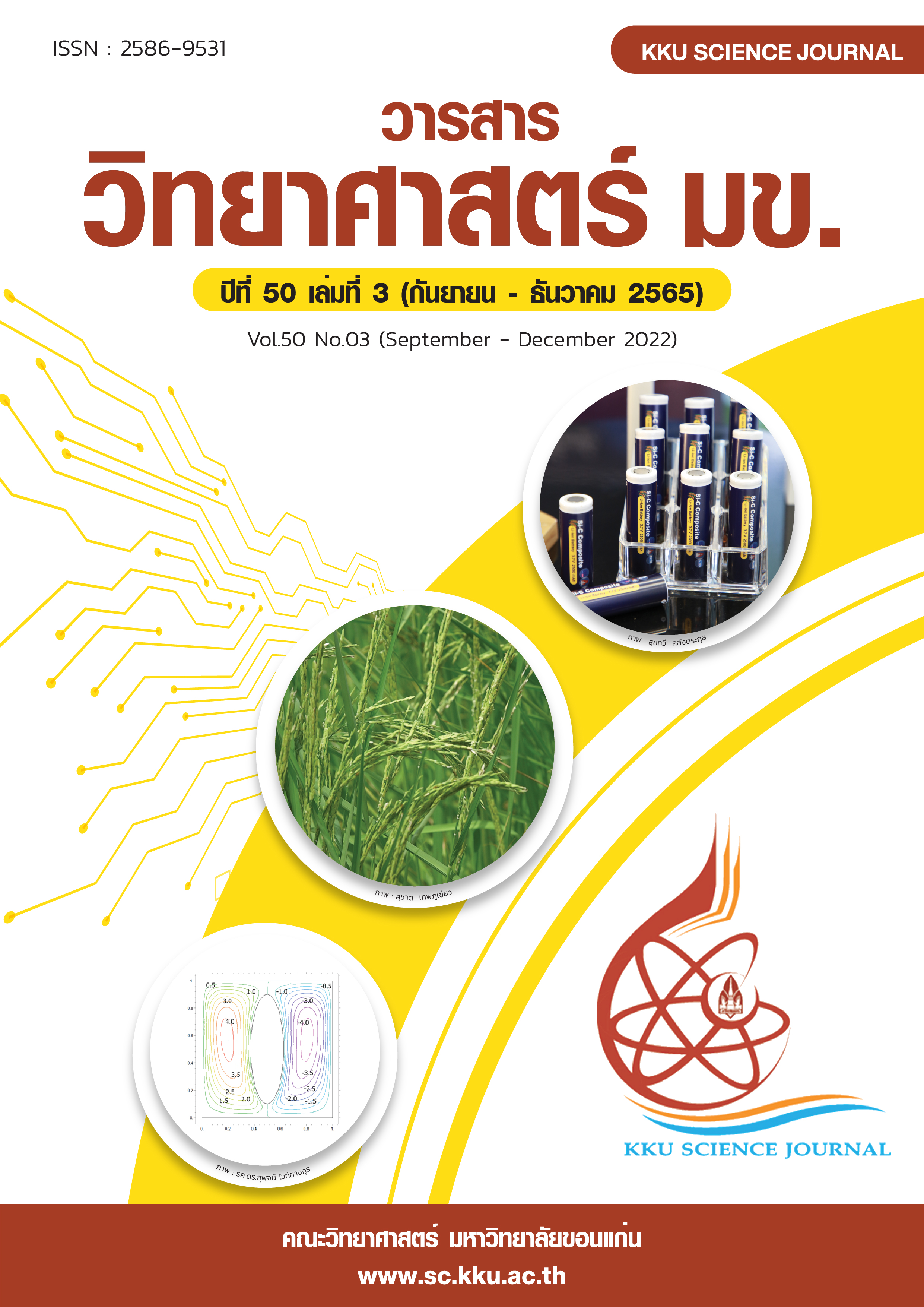Extraction and Biological Activity of Silk Sericin from Thai Native Silk (Bombyx mori L.) with Macerated Banana Leaves Solution
Main Article Content
Abstract
Sericulture in Thailand has continued to grow steadily, particularly in the North-eastern part. Silk production is one of the major industries that generates substantial income for farmers. Silk cocoon consist of two main proteins, fibroin and sericin. Fibroin has long been utilized in the textile industry and most recently, in tissue engineering as well as in advanced medical techniques. Sericin was previously regards as a silk industrial waste, however, recent findings suggested that sericin possess various bioactive compounds responsible for numerous applications. The objective of the study was to isolate and evaluate the biological properties of bioactive substances from Thai native silk Bombyx mori L. using non-chemical approach. The cocoon were extracted with macerated banana leaves (MBL) solution at 100 °C compared with conventional solvents extraction (hot water, sodium carbonate and extraction by autoclave method). The extraction parameters such as extraction time and solvent concentration were optimized. The results revealed that hot water and alkaline extracts showed higher degree of sericin recovery than the alternative green approach. The protein concentrations in all extracts were analyzed using Bradford assay and the total phenolics and flavonoids content in all extracts were determined and the antioxidant capacity were also analyzed based on ABTS assay and Potassium ferricyanide reducing power assay. Results indicated that, MBL extracted for 60 minutes contain highest amount of polyphenols (6.293 μg GAE/ gDW) and MBL extracted for 30 minutes has the most flavonoids (10.589 mg GAE/g DW). The MBL extracted for 60 minutes possesses the highest radical scavenging ability (77.543 ± 2.240% inhibition) with ABTS assay. The reducing ability of MBL extracted for 30 minutes appeared to possess maximum reducing power (Vitamin C equivalent = 245.651 ± 22.184 µg/ml). The finding of this study suggested that using macerated banana leaves solution for sericin extraction provide alternative method to obtain bioactive compounds that added value to the waste materials from local products.
Article Details

This work is licensed under a Creative Commons Attribution-NonCommercial-NoDerivatives 4.0 International License.
References
กนกพร พลเยี่ยม และสินีนาฏ ศิริ. (2556). การสกัดเซรินจากรังไหม Bombyx mori and Samila Cynthia ricini. ใน: การประชุมวิชาการการวิจัยเพื่อพัฒนาสังคมไทย “การประชุมหาดใหญ่ ครั้งที่ 4”. มหาวิทยาลัยหาดใหญ่, สงขลา. (43-51).
ธัญพรรณ ฮ่อบรรทัด. (2559). ประสิทธิภาพการสกัดเซซินจากเส้นไหมโดยขี้เถ้าเปลือกนุ่นและขี้เถ้าลูกขนุน ใน: การประชุมวิชาการระดับชาติและนานาชาติ “ราชภัฏวิจัยครั้งที่ 4” (กลุ่มวิทยาศาสตร์และ เทคโนโลยี). มหาวิทยาลัยราชภัฏบุรีรัมย์, บุรีรัมย์. (1163-1172).
ธีรธัช อาภรณ์, สาคร ชลธาร และรัตนพล มงคลรัตนาสิทธิ์. (2553). ประสิทธิภาพการลอกกาวไหมอีรี่โดยการ แช่รังไหมในสารละลายขี้เถ้าจากใบกล้วยและสบู่มาตรฐาน. วารสารวิจัยราชมงคลกรุงเทพ 14(2): 104-115.
นงนุช ศศิธร และกาญจนา ลอพงษ์. (2551). การลอกกาวไหมด้วยยางมะละกอ. วารสารวิชาการและวิจัย มทร.พระนคร 2(1): 70–75.
สินีนาฏ ศิริ และกนกพร พลเยี่ยม. (2560). การเพิ่มมูลค่าไหมบ้านและไหมอีรี่ด้วยการพัฒนาเป็นวัสดุปิดแผลที่ ใช้งานได้ด้วยเทคนิคอิเล็กโตรสปินนิง. รายงานวิจัยสาขาวิชาชีววิทยา สำนักวิชาวิทยาศาสตร์, มหาวิทยาลัยเทคโนโลยีสุรนารี.
Aramwit, P., Damrongsakkul, S., Kanokpanont, S. and Srichana, T. (2010).Properties and anti tyrosinase activity of sericin from various extraction methods. Biotechnology and Applied Biochemistry 55(2): 91-98.
Bradford, M.M. (1976). A rapid and sensitive method for the quantitation of microgram quantities of protein utilizing the principle of protein- dye binding. Analytical Bio-chemistry 72(1-2): 248-254.
Cao, T.T. and Zhang, Y.Q. (2016). Processing and characterization of silk sericin from Bombyx mori and its application in biomaterials and biomedicines.Materials Science and Engineering: C 61: 940-952.
Chandra, S., Khan, S., Avula, B., Lata, H., Yang, M.H., Elsohly, M.A. and Khan, I.A. (2014). Assessment of total phenolic and flavonoid content, antioxidant properties, and yield of aeroponically and conventionally grown leafy vegetables and fruit crops: A comparative study. Evidence - Based Complementary and Alternative Medicine 2014: 1-9.
Fan, J.B., Wu, L.P., Chen, L.S., Mao, X.Y., and Ren, F.Z. (2009). Antioxidant activities of silk sericin from silkworm Bombyx mori. Journal of Food Biochemistry 33(1): 74-88.
Jemli, M.E., Kamal, R., Marmouzi, I., Zerrouki, A., Cherrah, Y. and Alaoui, K. (2016). Radical-scavenging activity and ferric reducing ability of Juniperus thurifera (L.), J. oxycedrus (L.), J. phoenicea (L.) and Tetraclinis articulata (L.). Advances in Pharmacological Sciences 2016: 639-656.
Jena, K., Pandey, J. P., Kumari, R., Sinha, A.K., Gupta, V.P., and Singh, G.P. (2018). Tasar silk fiber waste sericin: New source for anti-elastase, anti-tyrosinase and anti-oxidant compounds. International Journal of Bio logical Macromolecules 114: 1102-1108.
Kato, N., Sato, S., Yamanaka, A., Yamada, H., Fuwa, N., and Nomura, M. (1998). Silk protein, sericin, inhibits lipid peroxidation and tyrosinase activity. Bioscience Biotechnology Biochemistry 62(1): 145-147.
Kunz, R.I., Brancalhão, R.M., Ribeiro, L.F., and Natali, M.R. (2016). Silkworm sericin: Properties and biomedical applications. Biomed Research International 2016: 1-19.
Padamwar, M. and Pawar, A. (2004). Silk sericin and its applications: A review. Journal of Scientific and Industrial Research 63: 323-329.
Pearson’s Correlation Coefficient. (2008). In Kirch, W. (Eds.) Encyclopedia of Public Health. Dordrecht: Springer-Verlag. pp. 1090-1091.
Re, R., Pellegrini, N., Proteggente, A., Pannala, A., Yang, M., and Rice-Evans, C. (1999). Antioxidant activity applying an improved ABTS radical cation decolorization assay. Free Radical Biology and Medecine. 26(9-10): 1231-1237.
Sasaki, M., Kato, N., Watanabe, H., and Yamada, H. (2000). Silk protein, sericin, suppresses colon carcinogenesis induced by 1,2-dimethylhydrazine in mice. Silk protein, sericin, suppresses colon carcinogenesis induced by 1,2-dimethylhydrazine in mice. Oncology Reports 7(5): 1049-1052.
Singleton, V.L., Orthofer, R. and Lamuela-Raventós, R.M. (1999). Analysis of total phenols and other oxidation substrates and antioxidants by means of Folin-Ciocalteu reagent. Methods in Enzymology 299: 152-178.
Takasu, Y., Yamada, H., Tsubouchi, K. (2002). Isolation of three main sericin components from the cocoon of the silkworm, Bombyx mori. Bioscience biotechnology and biochemistry 66(12): 2715-8
Tao, W., Li, M., and Xie, R. (2005). Preparation and structure of porous silk sericin materials. Macromolecular Materials and Engineering 290(3): 188-194.
Yun, H., Oh, H., Kim, M.K., Kwak, H.W., Lee, J.Y., Um, L.C. and Lee, K.H. (2013). Extraction conditions of Antheraea mylitta sericin with high yields and minimum molecula weight degradation. International Journal of Biological Macromolecules 52: 59-65.


